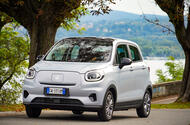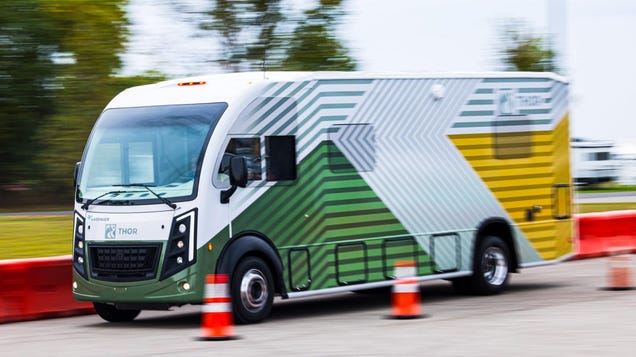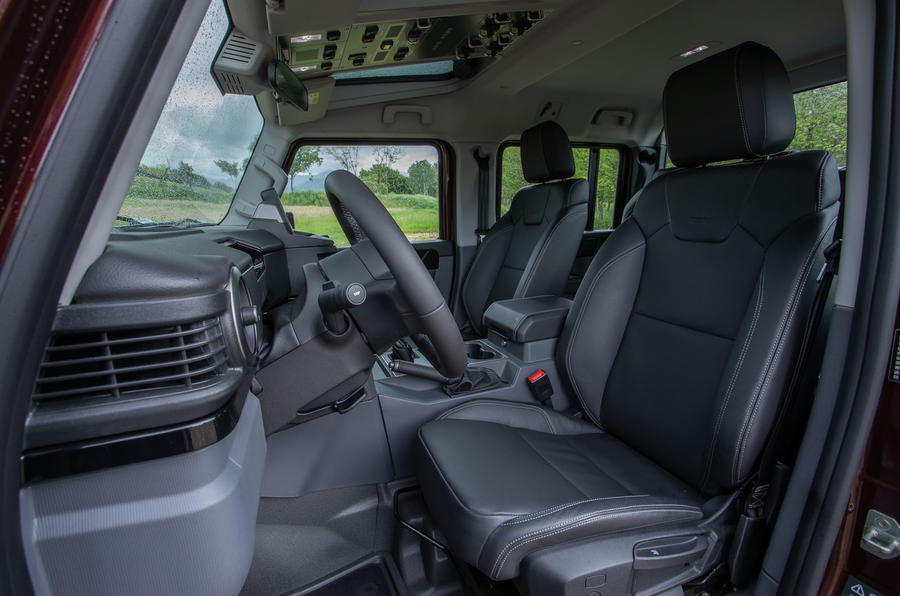Featured
Leapmotor T03: Giga Gears Overview
 Nascent Chinese electric car brand arrives in Europe with tiny electric city car
We’ve lost count of the number of Chinese brands that are coming to the UK, invariably planning to offer us the novelty of electric cars that look like they were styled by AI and named as imaginatively as your average photocopier.The Leapmotor T03 appears to perfectly fit the stereotype – except, it has one very important difference to its compatriots.You see, Leapmotors sold outside of China – starting with the T03 baby hatchback tested here and the big C10 family SUV – are actually sold by Leapmotor International, a joint venture owned 49:51 by the nascent Chinese company and Stellantis, the multinational giant that runs 14 brands from France, Italy, Germany, Britain and the US.The benefit of this, Leapmotor International CEO Tianshu Xin told us, is twofold: the brand can bypass the expensive set-up phase by simply adding its range to existing Stellantis showrooms across the nation; and potential customers will be reassured by familiarity and “360deg of support during the entire experience, from the selection of the vehicle to financing solutions and post-sales assistance services”. To say that Leapmotor – which began in Hangzhou a mere eight years ago by Zhu Jiangming, an electrical engineer with no prior automotive experience – is being ambitious about its growth abroad would be an understatement.It’s launching in Europe (including the UK), India, South-East Asia, Oceania and South America within the space of a year and expects to sell 250,000 cars this year – almost double its 2023 total – and 500,000 in 2030.It has defined its key brand values as affordability (it claims the T03 is the car that finally gives A- and B-segment buyers access to electric power, although the Dacia Spring will have something to say about that) and cutting-edge technology that takes the hassle out of your daily life.It certainly is one of the cheapest electric cars on sale at a mere £16k: that Leapmotor makes the majority of its parts in-house, hasn’t designed in superfluities and is harnessing Stellantis economies of scale apparently help the price, as does it being made on the old Fiat 500 line in Poland, not in China, and therefore avoiding both shipping costs and a 20% EU import tariff. View this post on Instagram A post shared by Autocar (@autocar_official)
Nascent Chinese electric car brand arrives in Europe with tiny electric city car
We’ve lost count of the number of Chinese brands that are coming to the UK, invariably planning to offer us the novelty of electric cars that look like they were styled by AI and named as imaginatively as your average photocopier.The Leapmotor T03 appears to perfectly fit the stereotype – except, it has one very important difference to its compatriots.You see, Leapmotors sold outside of China – starting with the T03 baby hatchback tested here and the big C10 family SUV – are actually sold by Leapmotor International, a joint venture owned 49:51 by the nascent Chinese company and Stellantis, the multinational giant that runs 14 brands from France, Italy, Germany, Britain and the US.The benefit of this, Leapmotor International CEO Tianshu Xin told us, is twofold: the brand can bypass the expensive set-up phase by simply adding its range to existing Stellantis showrooms across the nation; and potential customers will be reassured by familiarity and “360deg of support during the entire experience, from the selection of the vehicle to financing solutions and post-sales assistance services”. To say that Leapmotor – which began in Hangzhou a mere eight years ago by Zhu Jiangming, an electrical engineer with no prior automotive experience – is being ambitious about its growth abroad would be an understatement.It’s launching in Europe (including the UK), India, South-East Asia, Oceania and South America within the space of a year and expects to sell 250,000 cars this year – almost double its 2023 total – and 500,000 in 2030.It has defined its key brand values as affordability (it claims the T03 is the car that finally gives A- and B-segment buyers access to electric power, although the Dacia Spring will have something to say about that) and cutting-edge technology that takes the hassle out of your daily life.It certainly is one of the cheapest electric cars on sale at a mere £16k: that Leapmotor makes the majority of its parts in-house, hasn’t designed in superfluities and is harnessing Stellantis economies of scale apparently help the price, as does it being made on the old Fiat 500 line in Poland, not in China, and therefore avoiding both shipping costs and a 20% EU import tariff. View this post on Instagram A post shared by Autocar (@autocar_official) “McLaren F1 P1 Successor Unveiling on October 6 | Giga Gears”

P1's 903bhp plug-in hybrid powertrain was ahead of its time when it was unveiled in 2012"The next benchmark", set to stick with hybrid power, is a matter of days away
McLaren will reveal the next instalment in its Ultimate Series of hypercars on 6 October, just over a decade since the P1 arrived to replace the 240mph F1.
A video published by the company features those two hallowed hypercars and reveals that “the next benchmark” is inbound.
The new car is anticipated to take advantage of the developments made with electrified since the P1 was launched 12 years ago; McLaren having said on numerous occasions that there would need to be a generational change in technologies to justify a new ‘1’ car.
With a pure-electric McLaren supercar understood to still be some years off, this next ‘1’ hypercar is set to stick with a high-output hybrid powertrain that will no doubt comfortably outpace the 903bhp P1.
McLaren chief Michael Leiters last year told Autocar that the company was “not sure” on electric supercars yet because of their weight, at present.
“We don’t want to make a car that is 2000kg and 2000hp – anybody can do that,” said Leiters. “We want to make a car that is comparable to the 750 weight-wise,” he added.
Such a car will be possible “maybe at the end of the decade”.
“New Plug-In Hybrid Motorhome: 150-Mile EV Range & 500-Mile Total Range | Giga Gears”

Range anxiety is one primary roadblock that prevents people from transitioning to an electric vehiclefor their daily driver that often covers under 50 miles a day, so the concept of an electric recreational vehiclesounds like a sales disaster. To assuage those fears,Airstream’s parent company Thor Industries has…

“Recaro-Ineos Halt Reveals Supply Chain Vulnerabilities | Giga Gears”
 Ineos believes it could take until early 2025 to resume full production of its Grenadier 4x4
Ineos believes it could take until early 2025 to resume full production of its Grenadier 4x4
News that Ineos Automotive has been forced to stop production of the Grenadier off-roader because of a component shortage – understood to be seats from Recaro following its insolvency – underscores the fragility of the automotive supply chain, particularly for smaller car makers.
“Automotive supply chains are always complex and challenging, but this hits at such a busy time for us,” Ineos told Autocar in a statement. “We are leaving no stone unturned in our efforts to get our manufacturing back up and running, to catch up with demand as swiftly as we can.” The company’s “conservative scenario” was to be back at full production by early 2025.
Ineos didn’t officially name the supplier but a regional newspaper near the company’s production site in Hambach, eastern France, quoted plant manager Philippe Steyer as saying it was Recaro’s failure that forced the production stop this week, putting the 700-800 employees at the former Smart facility on short-time work.
The automotive seat manufacturer filed for insolvency in July and its current position is unknown. The company made seats for the more specialist end of the car market and lists among its customers Aston Martin (including for the Valkyrie hypercar) and Ford.
The danger of losing a supplier is ever present for car makers big or small. Often the best thing to do is to keep struggling suppliers either by organising supply chain finance – whereby a specialist bank steps in to provide upfront payment for parts – or even taking over, if they can afford to, said David Bailey, professor of business economics at the Birmingham Business School.
“Bigger firms will have second sourcing strategies so as to have some flexibility over where to source parts from, but Ineos Automotive is a tiny player,” Bailey said. “As a result, it is exposed when a key component maker struggles and may itself not have the resources to mount a rescue takeover.”
The Hambach plant MD said Ineos is evaluating alternative seats from four different companies. However, something as critical to the safety of the occupants such as a seat isn’t easy to replace at short notice. The new seat will have to be homologated, which involves passing safety tests, and then manufactured. Meanwhile, the stoppage will put a strain on existing suppliers, some of whom will be relying heavily on Ineos and the continued production of the Grenadier.

The greatest hope still rests with its original supplier. “Recaro is not off the table for us. It would be the best alternative," Steyer told the Saarbruecker Zeitung.
The overall Ineos Group head – billionaire Sir Jim Ratcliffe - can afford to buy Recaro outright, but a more practical option might be to team up with other Recaro customers to organise a bailout.
Car makers including JLR were forced to get financially creative back in 2021 to rescue Coventry-based Arlington Automotive Group – a maker of thermostats and other parts. JLR along with other customers approached a former manager to revive the company with the help of aluminium parts specialist Evtec, creating a new division called Evtec Automotive.
Meanwhile last year, General Motors, Stellantis and Yangfeng Interior systems came up with $15 million to prop up US-based automotive die-cut parts maker Unique Fabricating after it ran into financial problems. Eventually, Stellantis and two tier-one suppliers took over the company’s tooling, thereby avoiding expensive production stops.
Car companies have been forced to revaluate their often fiendishly complicated supply chains to try to avoid the consequences of natural disasters, such as tsunamis in Japan and more recently shortages of critical parts such as semiconductors.
The chip crisis was less financially critical in that it affected all car makers, allowing them to push up prices of the reduced numbers of cars they could make.
Typically, however, a parts shortage affects one or two brands, allowing their competitors to surge ahead. Recent examples include Audi’s inability to build V6- and V8-engined models earlier this year, reportedly due to problems with the Vitesco-supplied 48V mild-hybrid starter-generator. Such is the profitability of those bigger-engined models that the loss of sales resulted in Audi’s normally healthy profit margins falling to just 1.1% in the first quarter of the year. They have since rebounded after a second supplier was engaged.
Meanwhile, JLR and Porsche have both warned of reduced output in the second half of this year after aluminium production from a key supplier was hit by catastrophic flooding in Switzerland in early July.
Traditional car manufacturers have preferred in recent years to outsource much of the car’s content to suppliers - typically over three-quarters of the total parts - because specialist parts makers can more economically build and innovate in their chosen area.
However, the transition to electric has triggered a shift to bring more parts manufacturing in-house as car makers look to gain an edge and improve on components that might not be optimised for cars.
US electric vehicle start-up Rivian, for example, builds its own Enduro drive unit, which combines the gearbox, power inverter and motor in one. Even that is not immune, though, given the tiers of suppliers still needed. Currently, a supplier issue is causing a shortage of components – “a situation that continues to fuel internal debate between outsourcing and vertical integration,” according to Jefferies analyst Philippe Houchois, who recently visited the manufacturer.
In 2021, Mercedes-Benz bought out UK electric motor specialist Yasa, preferring to take control of the direction of a company that was innovative but also in the early stages of commercialisation, which is typically seen as bringing risks to its customers. How much risk these early-phase suppliers pose was illustrated by the failure of another innovative British electric motor maker – Saietta – in March.
One of former Ferrari CEO Amadeo Felisa’s first jobs at Aston Martin was to properly dig into the supply chain to make it more shock-resistant. As a result, he cut around 90 suppliers of the original 300. “A lot of them were very small – too small to make strategy or to follow us on efficiency and quality,” he said last year. His replacement, Adrian Hallmark, has spoken in his former role as head of Bentley about the need to bring in more suppliers to the UK with the capability and strength to become partners to the UK’s specialist, luxury-focused automotive industry.
Another option open to Ineos is to carry on building cars and store them at the Hambach site until the seats problem is sorted and they can be fitted retroactively. However, that currently doesn’t seem to be the plan.
A shortage of cars might actually be a help if you’ve got a unique product like the Ineos Grenadier. With fewer cars to sell, they can concentrate on their strategy of pushing up the pricing into a more luxury band. Bailey said: “‘Catch one while you can’ now might have to be the sales pitch from dealers.”

